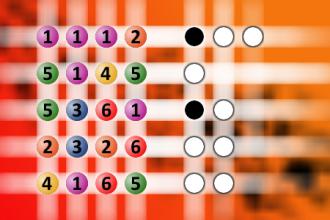Which is a winning combination of digits?
The computer chose a secret code (sequence of 4 digits from 1 to 6). Your goal is to find that code. Black circles indicate the number of hits on the right spot. White circles indicate the number of hits on the wrong spot.Correct answers: 32
The first user who solved this task is Nasrin 24 T.
#brainteasers #mastermind

Toilet Seat
A man decides to take the opportunity while his wife is away to paint the wooden toilet seat.
The wife comes home sooner than expected, sits, and gets the seat stuck to her rear. She is understandably distraught about this and asks her husband to drive her to the doctor.
She puts on a large overcoat so as to cover the stuck seat, and they go.
When they get to the doctor's, the man lifts his wife's coat to show their predicament. The man asks, "Doctor, have you ever seen anything like this before?"
"Well, yes," the doctor replies, "but never framed."

